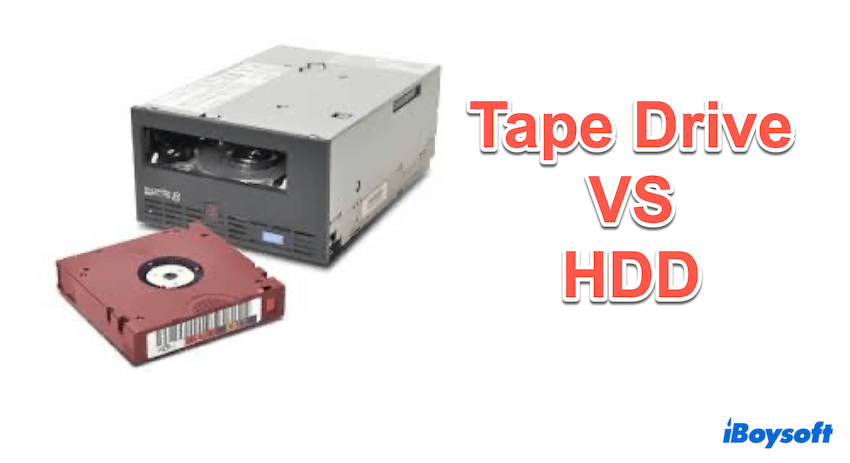Written by
Sherry SongMagnetic Tape Storage Full Introduction
Summary: Have you used Tape drives? While they may seem to be forgotten in the past, they still play a great role in certain fields due to their unique advantages. Here we will give a brief introduction to Tape Drive from iBoysoft.

Tape drives, also known as Tape storage, are a type of data storage technology that utilizes magnetic tape to store digital information of the computer. Like other storage, the data recorded on it can be read and erased.
While they may seem like a relic of the old years of cloud storage and solid-state drives(SSDs), Tape drives can still be widely used in some industries and applications compared with HDDs and SSDs.
In this post, we can learn the parts, the usages, the strengths, and the weaknesses of the Tape drive, keep reading.
Components and Examples of Tape Drive
Firstly, we should know the main parts of the Tape drives and the key examples of it.
Components of Tape drive
- Tape Cartridge: This is the actual storage medium, usually a spool of magnetic tape wound inside a protective cartridge.
- Read/Write heads: These heads interacts with the magnetic surface of the tape, encoding and decoding the data.
- Tape transport mechanism: This mechanism moves the tape within the drive, controlling its speed and position.
- Control electronics: These govern the operation of the Tape drive, managing tasks such as data transfer, error correction, and drive diagnostics.
There are other parts like the Motor, Data Buffer, and Control Panel or interface...They work together to enable the reliable storage and retrieval of data on magnetic tape storage.
Examples of Tape drive
- Linear Tape-Open(LTO): LTO Tape drives come in different generations(such as LTO-7, and LTO-8...), offering high-capacity and high speed for backup and archiving.
- Digital Linear Tape(DLT): DLT has been adopted by various organizations for its reliability and scalability.
- IBM's 3592: IBM 3592 Tape drives are commonly used in enterprise environments for backup, archiving, and data retention tasks.
These are just a few examples of Tape drives available in the market, each offering unique features to meet the diverse storage needs of organizations and businesses. Why not share to help more ones?
Pros and Cons of Tape Drive
Next, knowing the pros and cons of the Tape drive is also important, you can think twice when choosing it:
| Pros | Cons |
| High storage capacity with modern tapes storing multiple terabytes of data | Slower access speed compared to HDDs and SSDs |
| More cost-effective than others, particularly for long-term archival purposes | Limited random access, being impractical for certain applications |
| Durability for heat, humidity... | Physical fragility if mishandled or exposed to harsh conditions |
| Longevity for storing data for extended periods without degradation | Needs regular maintenance |
If they help you make a better choice, please share it on your social platforms.
Tape Drive VS HDD: which is better?
The comparison between Tape drives and HDDs depends on the specific requirements and priorities of the user or organizations. Here's a breakdown of the key factors to consider in Tape drive VS HDDs:

| Tape Drives | HDDs | |
| Capacity | Higher storage capacity, which can store TB to PB of data | Has larger capacities compared to individual tape cartridges |
| Cost | More cost-effective, especially for the per gigabyte of storage | More expensive but the upfront cost of HDDs is lower |
| Speed | Optimized for sequential data access, but slower for random access | Excels in random access, offering faster read and write speeds for accessing data |
| Reliability | Longer shelf life | Being sensitive to environmental conditions and carrying a risk of data loss |
| Accessibility | Not suitable for apps requiring frequent access but excels in large-scale backup and archival | Suitable for primary storage apps that need fast access to data |
In conclusion, neither Tape drives nor HDDs are inherently “better” than the other. The choice depends on factors of your own, like storage capacity requirements, budget constraints, speed of access, and reliability considerations...

